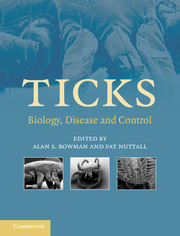Book contents
- Frontmatter
- Contents
- List of contributors
- Preface
- 1 Systematics and evolution of ticks with a list of valid genus and species names
- 2 The impact of tick ecology on pathogen transmission dynamics
- 3 Tick salivary glands: the physiology of tick water balance and their role in pathogen trafficking and transmission
- 4 Tick saliva: from pharmacology and biochemistry to transcriptome analysis and functional genomics
- 5 Tick toxins: perspectives on paralysis and other forms of toxicoses caused by ticks
- 6 Tick lectins and fibrinogen-related proteins
- 7 Endocrinology of tick development and reproduction
- 8 Factors that determine sperm precedence in ticks, spiders and insects: a comparative study
- 9 Tick immunobiology
- 10 Saliva-assisted transmission of tick-borne pathogens
- 11 Lyme borreliosis in Europe and North America
- 12 Viruses transmitted by ticks
- 13 Babesiosis of cattle
- 14 Theileria: life cycle stages associated with the ixodid tick vector
- 15 Characterization of the tick–pathogen–host interface of the tick-borne rickettsia Anaplasma marginale
- 16 Emerging and emergent tick-borne infections
- 17 Analysing and predicting the occurrence of ticks and tick-borne diseases using GIS
- 18 Acaricides for controlling ticks on cattle and the problem of acaricide resistance
- 19 Anti-tick vaccines
- 20 Anti-tick biological control agents: assessment and future perspectives
- 21 Pheromones and other semiochemicals of ticks and their use in tick control
- Index
- References
21 - Pheromones and other semiochemicals of ticks and their use in tick control
Published online by Cambridge University Press: 21 August 2009
- Frontmatter
- Contents
- List of contributors
- Preface
- 1 Systematics and evolution of ticks with a list of valid genus and species names
- 2 The impact of tick ecology on pathogen transmission dynamics
- 3 Tick salivary glands: the physiology of tick water balance and their role in pathogen trafficking and transmission
- 4 Tick saliva: from pharmacology and biochemistry to transcriptome analysis and functional genomics
- 5 Tick toxins: perspectives on paralysis and other forms of toxicoses caused by ticks
- 6 Tick lectins and fibrinogen-related proteins
- 7 Endocrinology of tick development and reproduction
- 8 Factors that determine sperm precedence in ticks, spiders and insects: a comparative study
- 9 Tick immunobiology
- 10 Saliva-assisted transmission of tick-borne pathogens
- 11 Lyme borreliosis in Europe and North America
- 12 Viruses transmitted by ticks
- 13 Babesiosis of cattle
- 14 Theileria: life cycle stages associated with the ixodid tick vector
- 15 Characterization of the tick–pathogen–host interface of the tick-borne rickettsia Anaplasma marginale
- 16 Emerging and emergent tick-borne infections
- 17 Analysing and predicting the occurrence of ticks and tick-borne diseases using GIS
- 18 Acaricides for controlling ticks on cattle and the problem of acaricide resistance
- 19 Anti-tick vaccines
- 20 Anti-tick biological control agents: assessment and future perspectives
- 21 Pheromones and other semiochemicals of ticks and their use in tick control
- Index
- References
Summary
INTRODUCTION
In ticks, as in most animals, chemical mediators guide behaviour. These information-bearing compounds, known as semiochemicals, are secreted external to the animal body and, when recognized, direct a specific behavioural response such as food and mate location, escape and other behaviours. Chemical signalling between individuals is clearly one of the earliest types of information exchange to appear in the long history of life on Earth, long before visual or auditory stimuli developed. Indeed, chemical communication via semiochemicals remains the dominant form of communication among many animals. Despite similarities with cell signalling (e.g. cytokines) among the cells of the metazoan animal, or hormones (e.g. ecydsteroids) that stimulate specific physiological responses (e.g. moulting), semiochemicals are fundamentally different in that they are secreted outside of the animal body, are recognized externally and modify the behaviour of the entire individual. With the advances in modern chemistry, biochemistry and molecular biology during the past several decades, a vast literature has accumulated concerning the variety of semiochemicals, their chemical composition, biosynthesis, secretion and perception, and the varying biological roles that these compounds regulate.
Collectively, the repertoire of chemical compounds used within a species or among competing species forms a simple chemical communication system, or chemical language. In many species, this chemical language consists of an ordered hierarchy of specific compounds that are secreted and perceived in a precise, sequential order leading to a desired end result. In others, a single compound (e.g.
- Type
- Chapter
- Information
- TicksBiology, Disease and Control, pp. 470 - 491Publisher: Cambridge University PressPrint publication year: 2008
References
- 4
- Cited by



